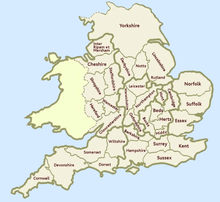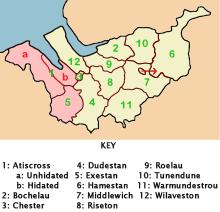Gerbod the Fleming, 1st Earl of Chester
Gerbod the Fleming, of Oosterzele, 1st Earl of Chester, was a hereditary advocate of the Abbey of Saint Bertin at Saint-Omer, Flanders (now France) and Earl of Chester in 1070.[1]

Life
Gerbod of Oosterzele was the son of another Gerbod, hereditary advocate of the abbey of Saint-Bertin.[1][2][3] Among the fourteen tenants-in-chief from Flanders, Gerbod the Fleming was one of the most prominent.[4] His family held the lordships of Oosterzele and Scheldewindeke, the overlordship of Arques and territorial rights in Saint-Omer.[5] In 1066 he was in the service of William the Conqueror,[6] most probably at the battle of Hastings,[3] and between 1067 and 1070 was created Earl of Chester, holding a large portion of that county along with the city of Chester forming the county palatine of Chester.[7] His brother Frederic was a tenant-in-chief in East Anglia and his sister Gundred married William I de Warenne, later 1st Earl of Surrey, whose caput was Castle Acre in Norfolk.[1][5][8][9]
Gerbod was mentioned as being a part of the reduction of Cheshire in 1070 by the Conqueror, at which time Gerbod was given the Earldom of Chester. Orderic Vitalis reports that Gerbod was harassed by both English and Welsh in his new position and he may have been glad to return to Flanders later that same year.[10] This may also have been due to concerns having to do with the death of the Count of Flanders, Baldwin VI, and the subsequent civil war.[11]
According to Orderic he fought in the Battle of Cassel in February 1071 in Flanders where he fell into the hands of his enemies and was held captive. William I, seeing the earldom vacant, used his imprisonment as a reason for giving the earldom of Chester to Hugh 'Lupus' d'Avranches.[12] The Hyde Chronicle reported Gerbod died a prisoner.[13] However, an English and a Norman source both state that Gerbod was not imprisoned following Cassel,[9] Instead he fled to Rome to seek forgiveness for the sin of killing Arnulf III, Count of Flanders, his liege lord during the battle. Pope Gregory VII sent him to Hugh, Abbot of Cluny.[14][15] Gerbod remained at Cluny becoming a distinguished monk within its ecclesiastical community.[15]
Prior to him becoming a monk, Gerbod married Ada (last name unknown)[lower-alpha 1] and had at least three children.
Issue
- Arnulf III of Oosterzele-Scheldewindeke.[2]
- Gerbod III of Oosterzele-Scheldewindeke.[2]
- Albert of Scheldewindeke.[2]
See also
- List of Earls in the reign of William the Conqueror
References
- David C. Douglas, William The Conqueror (University of California Press, Berkeley & Los Angeles, 1964), p. 267
- E. Warlop, The Flemish Nobility Before 1300, Part II Annexes, Volume 2 (G. Desmet-Huysman, Belgium, 1976) p. 1021
- Heather J. Tanner, Families, Friends and Allies: Boulogne and Politics in Northern France and England c.879-1160 (Brill, Leiden, 2004), p. 83 n. 55
- David Nicholas, Medieval Flanders (Longman Group UK Limited, 1992) p 54
- Freda Anderson, 'Uxor mea', the First Wife of the First William of Warenne, Sussex Archaeological Collections, Vol. 130 (Sussex Archaeological Society, 1992). p.107
- Judith A. Green, The Aristocracy of Norman England (Cambridge University Press, 1997) p. 43
- George Edward Cokayne, The Complete Peerage, ed. Vicary Gibbs, Vol. iii (The St. Catherine Press, Ltd., London, 1913) p. 164
- William Farrer, Charles Travis Clay,Early Yorkshire Charters, Volume VIII - The Honour of Warenne (The Yorkshire Archaeological Society, 1949) p. 45
- Elizabeth van Houts, 'Hereward and Flanders,' Anglo-Saxon England, Vol. 28 (Press Syndicate of the University of Cambridge, 1999), p. 219
- Robert H. George, "The Contribution of Flanders to the Conquest of England (1065-1086)", Revue belge de philologie et d'histoire, 5/1 (1926), pp. 81-99
- C.P. Lewis, 'The Formation of the Honor of Chester, 1066-1100,' The Earldom of Chester and its Charters; A Tribute to Geoffrey Barraclough, ed. A.T. Thacker, Journal of the Chester Archaeological Society, Chester, Vol. 71, 1991, p.39
- Ordericus Vitalis, The Ecclesiastical History of England and Normandy, Translated by Thomas Forester Henry G. Bohn, London, MDCCCLIV (1854), p. 47
- Hyde Abbey, Liber Monasterii de Hyda: Comprising a Chronicle of the affairs of England, ed: Edward Edwards, Longmans, Green, Reader, and Dyer, London, 1866, p. 296
- Karl Hanquet (ed.), La Chronique de Saint-Hubert dite Cantatorium (Hayez, Imprimeur de L'Academie, Bruxelles, 1906), pp. 66-67.
- Gilbert of Mons, Chronicle of Hainaut, Translated by Laura Napran (Boydell Press, Woodbridge, 2005), pp. 6-7

